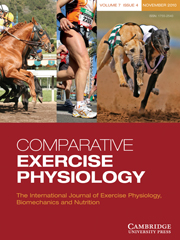Article contents
Comparison between a sensor (3D accelerometer) and ProReflex motion capture systems to measure stride frequency of horses on a treadmill
Published online by Cambridge University Press: 01 November 2008
Abstract
The most popular techniques used for studying equine kinematics are videographic recording combined with the analysis using a commercial software package or optoelectronic systems based on emission and detection of infrared or visible light. Such systems can be expensive, complicated to use and their use may be restricted to indoor use (in the case of infrared systems) or a limited number of strides when used outdoors. Recently, there has been considerable interest in monitoring motion using inertial measuring systems. The purpose of the present study was to determine the accuracy of the Pegasus system (European Technology for Business Ltd., Codicote, UK), which determines stride frequency directly when mounted on the withers. Eight horses of different breeds and sizes (447–588 kg) were studied at walk, trot and two speeds at canter on a treadmill. Simultaneous measurements of stride were made using the Pegasus and ProReflex motion capture systems. Mean stride frequencies (n = 8 horses) for the ProReflex and Pegasus systems at walk (0.86 ± 0.05 and 0.87 ± 0.05 strides per second, respectively), trot (1.36 ± 0.07 and 1.36 ± 0.07 strides per second, respectively) and canter (7 m s− 1: 1.92 ± 0.05 and 1.92 ± 0.05 strides per second, respectively; 8 m s− 1: 1.93 ± 0.05 and 1.94 ± 0.05 strides per second, respectively) were not significantly different (P>0.05). The mean difference between the two systems for all four speeds was − 0.002 strides per second (lower 95% CI: − 0.016; upper 95% CI: 0.011; P = 0.309). In conclusion, the differences between stride frequency measurements made with the Pegasus and ProReflex systems in horses exercising at walk, trot and slow canter on a treadmill are < 1% and not likely to be of physiological significance.
Information
- Type
- Short Communication
- Information
- Copyright
- Copyright © Cambridge University Press 2009
References
- 6
- Cited by

